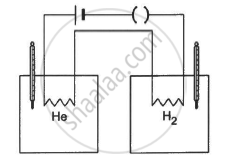Advertisements
Advertisements
Question
An ideal gas expands from 100 cm3 to 200 cm3 at a constant pressure of 2.0 × 105 Pa when 50 J of heat is supplied to it. Calculate (a) the change in internal energy of the gas (b) the number of moles in the gas if the initial temperature is 300 K (c) the molar heat capacity Cp at constant pressure and (d) the molar heat capacity Cv at constant volume.
Solution
Initial volume of the gas, V1 = 100 cm3
Final volume = V2 = 200 cm3
Pressure = 2 × 105 Pa
Heat supplied, dQ = 50 J
(a) According to the first law of thermodynamics,
dQ = dU + dW
dW = PΔV = 2 × 105 × (200 -100) × 10-6 = 20
Initial volume of the gas, V1 = 100 cm3
Final volume = V2 = 200 cm3
Pressure = 2 × 105 Pa
Heat supplied, dQ = 50 J
(a) According to the first law of thermodynamics,
dQ = dU + dW
`"U" = 3/2 "n""R""T"`
`30 = n xx 3/2 xx 8.3 xx 300`
`=> n = 2/(83 xx3) = 2/249 = 0.008`(c) Also,
dU = nCvdT
`=> "C"_"V" = ("d""U")/ ("n""d""T") = 30 /(0.008 xx 300) = 12.5`
Cp = Cv + R = 12.5 + 8.3 = 20.8 J/mol-K
(d) Cv = 12.5 J/mol-K
APPEARS IN
RELATED QUESTIONS
A metre long narrow bore held horizontally (and closed at one end) contains a 76 cm long mercury thread, which traps a 15 cm column of air. What happens if the tube is held vertically with the open end at the bottom?
The specific heat capacity of water is
Does a gas have just two specific heat capacities or more than two? Is the number of specific heat capacities of a gas countable?
Can we define specific heat capacity at constant temperature?
In a real gas, the internal energy depends on temperature and also on volume. The energy increases when the gas expands isothermally. Examining the derivation of Cp − Cv = R, find whether Cp − Cv will be more than R, less than R or equal to R for a real gas.
Can a process on an ideal gas be both adiabatic and isothermal?
Can two states of an ideal gas be connected by an isothermal process as well as an adiabatic process?
Let ∆Wa and ∆Wb be the work done by the systems A and B, respectively, in the previous question.
Three identical adiabatic containers A, B and C contain helium, neon and oxygen, respectively, at equal pressure. The gases are pushed to half their original volumes.
(a) The final temperatures in the three containers will be the same.
(b) The final pressures in the three containers will be the same.
(c) The pressures of helium and neon will be the same but that of oxygen will be different.
(d) The temperatures of helium and neon will be the same but that of oxygen will be different.
A mixture contains 1 mole of helium (Cp = 2.5 R, Cv = 1.5 R) and 1 mole of hydrogen (Cp= 3.5 R, Cv = 2.5 R). Calculate the values of Cp, Cv and γ for the mixture.
Air (γ = 1.4) is pumped at 2 atm pressure in a motor tyre at 20°C. If the tyre suddenly bursts, what would be the temperature of the air coming out of the tyre? Neglect any mixing with the atmospheric air.
The figure shows two vessels with adiabatic walls, one containing 0.1 g of helium (γ = 1.67, M = 4 g mol−1) and the other containing some amount of hydrogen (γ = 1.4, M = 2 g mol−1). Initially, the temperatures of the two gases are equal. The gases are electrically heated for some time during which equal amounts of heat are given to the two gases. It is found that the temperatures rise through the same amount in the two vessels. Calculate the mass of hydrogen.

The speed of sound in hydrogen at 0°C is 1280 m s−1. The density of hydrogen at STP is 0.089 kg m−3. Calculate the molar heat capacities Cp and Cv of hydrogen.
Standing waves of frequency 5.0 kHz are produced in a tube filled with oxygen at 300 K. The separation between the consecutive nodes is 3.3 cm. Calculate the specific heat capacities Cp and Cv of the gas.
Molar specific heat of water is C = 74.7 J/mol K, its value in cal/g K is ______.
If at same temperature and pressure, the densities for two diatomic gases are respectively d1 and d2 then the ratio of velocities of sound in these gases will be ______.
